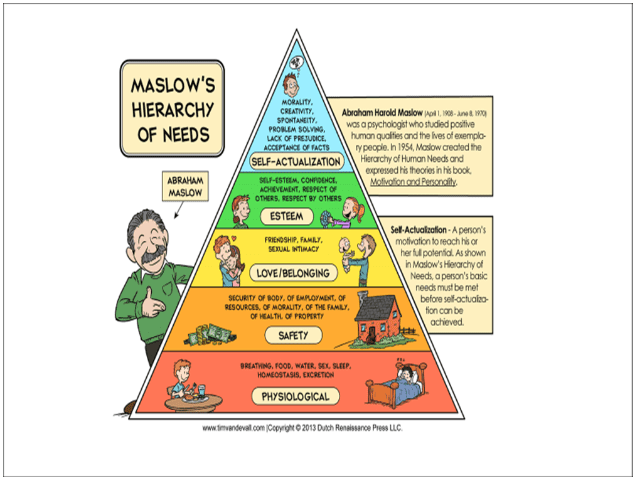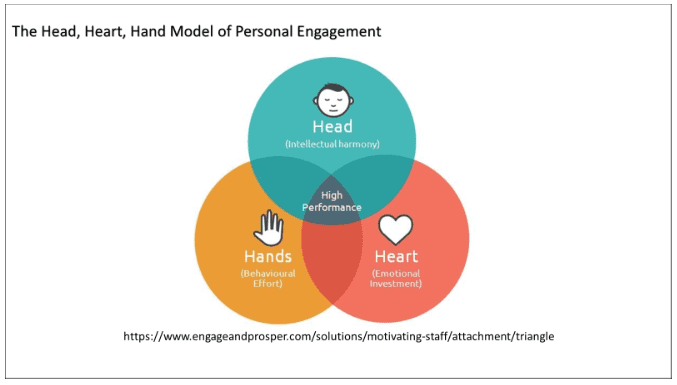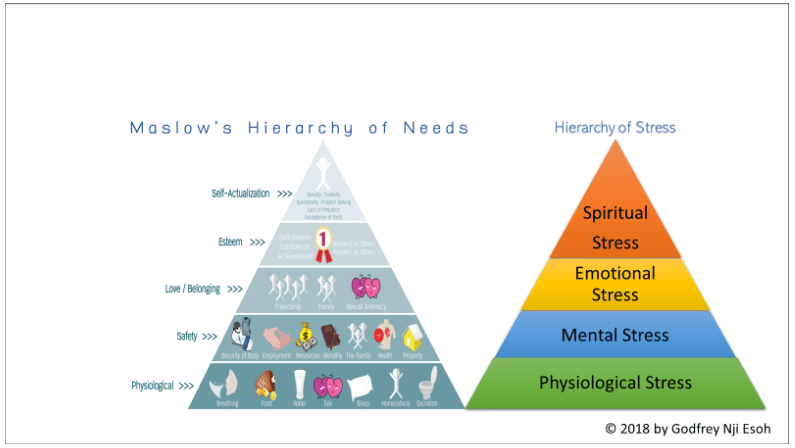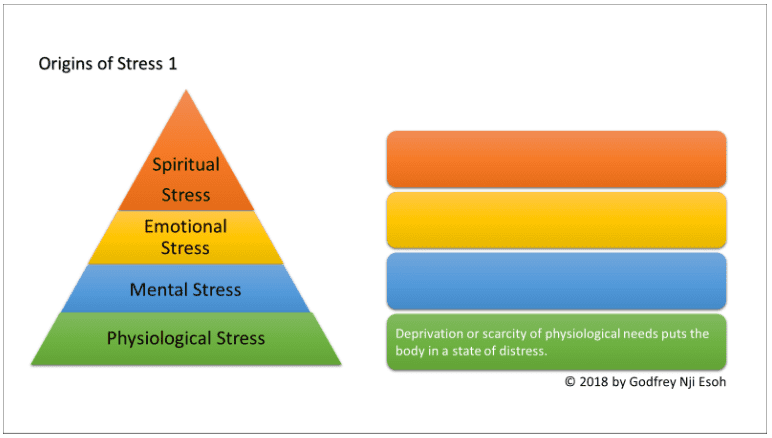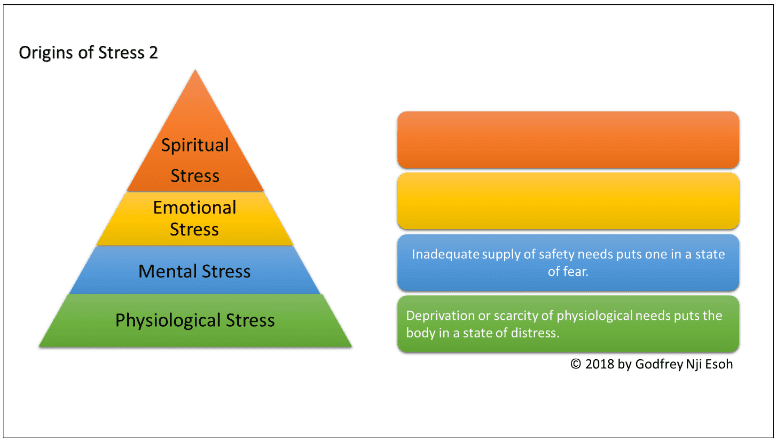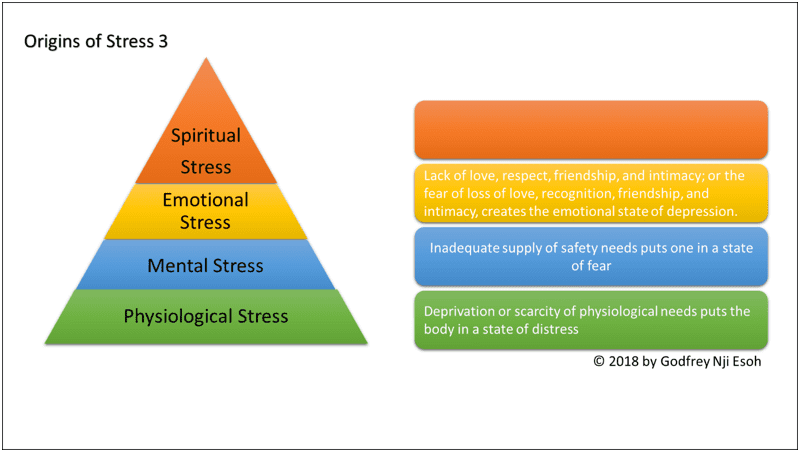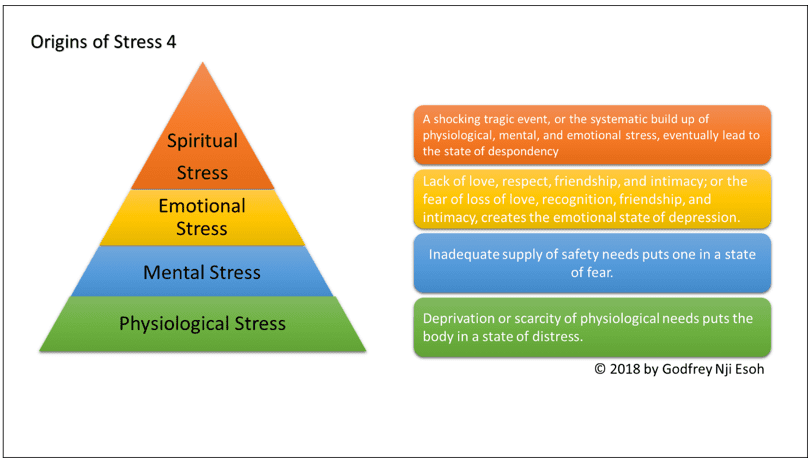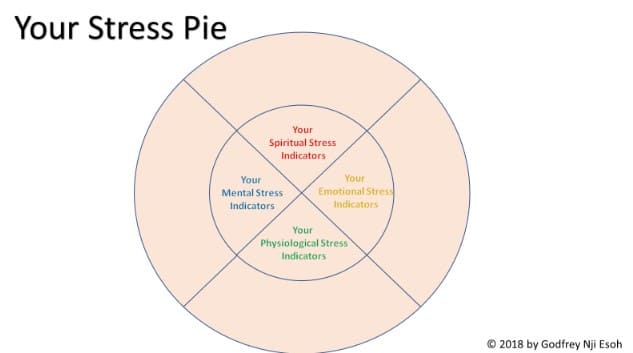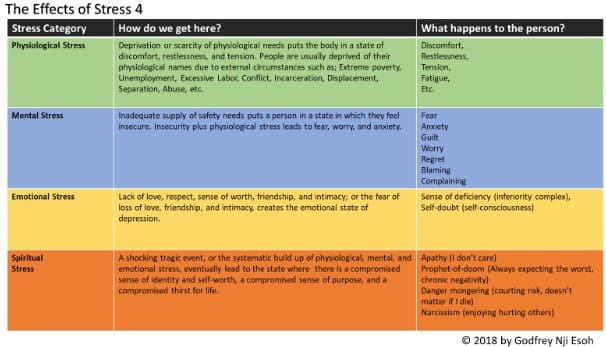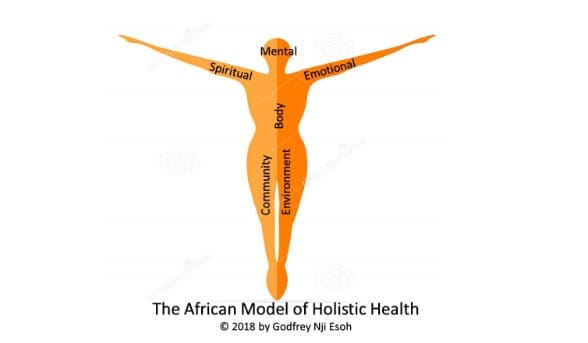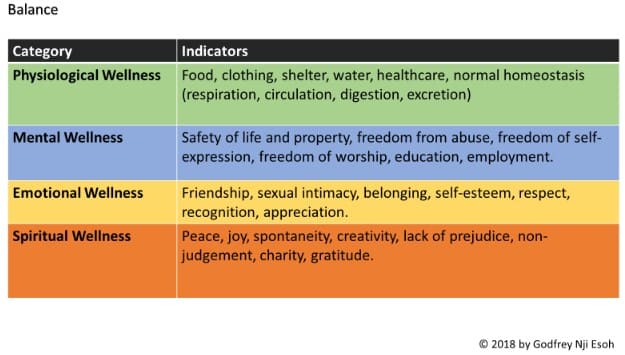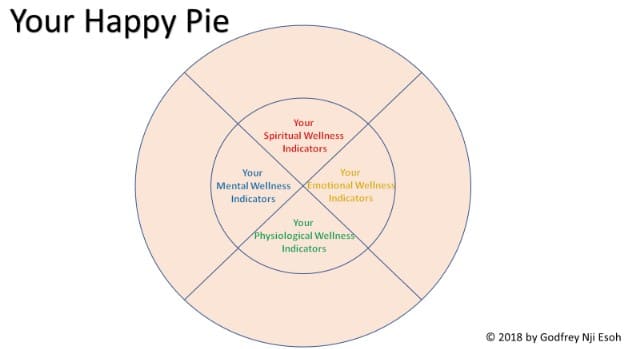As mentioned earlier in this course, stress is a normal response to either positive or negative stimuli in our daily lives. In a sense, stress is actually healthy. It is simply a signaling system to tell us that something has changed in our internal or external environment, thereby inviting us to take action to adapt, such as to protect ourselves. Understanding one’s stress and developing proactive strategies to cope with stress is therefore a vital part of human life.
When stress is poorly handled, depression is the result. Unfortunately, most people are unaware of their stress dynamic and it often only when they have developed mental health problems that they start seeking solutions. As is always the case, we find that prevention is better than cure. Empowering people with the skills to understand their stress dynamic and proactively manage their stress will keep many people out of depression and avert the many morbidities and mortalities that are engendered by depression.
Just as we have a hierarchy of needs, we can infer a hierarchy of stress. Physiological stress is a result of deprivation of physiological needs. Mental stress results from deprivation of safety needs. Emotional stress results from deprivation of belonging and self-esteem needs. Spiritual stress results from deprivation of self-actualization needs. The following section gives an overview of each of these categories of stressors.
Distress: Response to physiologic stress.
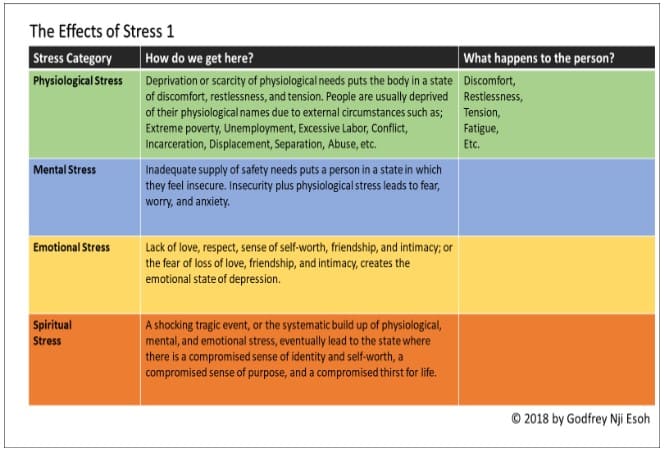
When a person person’s physiological needs are not adequately met, the state of distress is the result.
A distressed person is basically an uncomfortable person. Discomfort is so common that people hardly notice that it is a form of stress that often leads to more serious mental health issues if allowed to persist for long. The cycle of desire-satisfaction- desire is normal in human life. We all wake up every morning with the goal of making our lives more comfortable.
When an environment is conducive for the progressive improvement of a person’s conditions in life to something more and more comfortable, then that person is in a state of health. When an environment is so hostile that one’s basic needs are not met and one is forced to live in perpetual discomfort, say hunger, then that person is in a state of stress. When discomfort is allowed to persist for long, it degenerates to a more serious mental health issue.
So the thing to note here is that as humans, some form of distress or another is part and parcel of our daily lives. It is our distress that pushes us to seek a more comfortable and more expanded life. What is undesirable is deprivation – the situation in which people are unable to meet their needs because of hostile circumstances beyond their control.
Responses to distress
When people are uncomfortable on a consistent basis, the next thing is that they start worrying. For example, they worry about where their next meal will come from, they worry about when they will be kicked out of the place where they are taking shelter.
An uncomfortable and worrisome person usually finds it difficult to focus on the present moment or on the task at hand. Since their thoughts are always buried in the memory of past discomfort and fear of future discomfort, they are often very distracted from current reality.
Worrisome and distracted people also have the tendency to be very irritable. The feeling of uneasiness or embarrassment is also a common feature among people who are conscious of their lack of basic needs.
Adaptations to distress
It is hard to imagine life without water. But if you are one of those who has so much water to drink, cook, bathe, do your laundry, and water your garden, you probably take the importance of water for granted. The amount of water you used in bathing this morning without even thinking about it is the amount of water some people trek hundreds of miles to fetch and preserve for drinking for at least a week. Access to potable water is still a major problem in developing countries. In some regions the problem is made worse by natural causes such as draughts and climate change that is systematically drying up water sources. Again, poverty is implicated in water access in the sense that some people are stuck in dry places simply because they have nowhere else to go to.
Clothing
Clothing is been transformed capitalistic society into a lucrative fashion industry to the extent that we have lost sight of the fact that the ability to decently cover one’s nakedness is a fundamental human need. There are millions of people around the world who do not have clothes and shoes to wear. While this does not matter to some indigenous communities where everyone is running around half-naked, it can be a serious problem when you live in a modern society and you are always feeling self-conscious because of that one pair of shoes and one shirt that has become like a uniform to you.
Healthcare
Healthcare is a crucial physiological need because it involves all the interventions, both preventive and curative, that ensure that the homeostatic functions of the body are in optimal shape. Where people lack access to basic healthcare whether due to financial, geographical or social barriers, the quality of life is severely impaired. Unfortunately, this is true for billions of people across the globe.
Greed
Greed is the selfish and excessive or intense desire to have more material things like food, money, etc. than one really needs. A greedy person is basically possessive of material things because he/she has an unconscious fear of the absence of these things. Most of the times we judge greed on the surface, but when we look deeper, we will usually find its origins in some past state of chronic deprivation.
Hoarding
Hoarding is an obsession with things and constitutes one of the variants of greed. A hoarder piles up things that he/she does not need, and cannot explain why he/she is piling them up.
Binging
We are all family with those people who go to a party and eat enough food to last them a week, or youths who once they have started drinking, will not stop until the bar is empty. Binging is a very common tendency in all societies both affluent and poor. With the advent of movie series, people now binge with TV as well, since they won’t stop watching a movie till they have completed the whole season.
Stealing
Some people resort to taking what belongs to others as a means of meeting their own needs. Stealing usually begins as the innocent childhood tendency to grab something that no one would otherwise give you, out of sheer survival instinct. But the more habitual it becomes, the more it takes root into a person’s personality. Some people grow out of it as life gets better, but others never recover. They go on to become robbers, gangsters, or the white-collar gangsters we find in business and politics.
Fear: Response to mental stress.
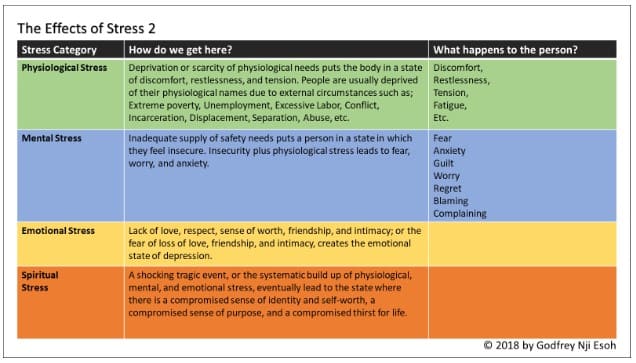
When people are deprived of their survival needs, mental stress results. The state of mental stress is basically the state of fear. The common types of fear are:
Fear of failure
People are afraid to enter into relationships, apply for jobs, start businesses, make a speech, and so on because of the gripping fear that it will not work out.
Fear of the unknown
That which is familiar is the comfort zone for most people. The sense of self is often so fragile that people will rather remain in their comfort zone they know, no matter how ‘uncomfortable’ it is, than venture into some unknown territory. They feel safe, even in their pain because it is the only thing they know.
Fear of pain
People who have ever experienced pain naturally have their system programmed to avoid pain. This is the case especially with people who have in the past suffered injury or abuse. It can be physical or emotional.
Fear of loss
We are all too familiar with the paradox where a person is passionate about having a certain object or relationship, and then the moment they have it, that same passion becomes transformed into the fear of losing that thing or person. The fear of loss makes people behave in weird ways, although in their eyes they are being protective and loving.
Fear of rejection
The major reason why people fear failure is that in their minds, failure is synonymous to loss. This is especially true among people who are under peer pressure to maintain certain standards as a condition to deserve membership in a certain click. In a broader sense, people whose sense of self is attached to the ego and the social perks they received from society are terrified by the prospects of losing this social pride should they encounter defeat or failure in a certain venture.
Conditioned fear
A conditioned fear, also known as a phobia is an exaggerated, often illogical and inexplicable fear for an object, a group of things, or an experience. The number of phobias that are now recognized by the psychological community is way above one hundred.
Response to Fear
The state of fear is the state in which a person feels insecure because of their awareness that something of vital importance is missing in their lives. Fear goes deeper than the physiological responses. It is a conscious awareness of deficiency.
The survival needs are the needs that a person needs to function normally in the physical environment, but unlike tangible (physiological) needs like food, the survival needs are intangible, such as education, employment, safety, human rights, freedom to enjoy life, etc. Just as the adrenaline rush is triggered to prepare the physical body for fight or flight when one is physically threatened, the mind has its own defense mechanisms that are triggered when one’s survival is threatened by the absence of the safety needs.
People respond to fear in various ways, the common ones being the feeling of inferiority,
- • Avoidance
- • Negative Self-talk
- • Anxiety
- • Pessimism
- • Complaining
- • Blaming
- • Excuses
- • Discouragement
Adaptations to Fear
When the passive responses to fear become permanent, the mind naturally improvises a means of survival. People who live in chronic fear demonstrate tendencies such as:
- • Bitterness
- • Envy
- • Cynicism
- • Discouragement
- • Panic
- • Substance Abuse
- • Self-sabotage
- • Paranoia
Depression: Response to emotional stress.
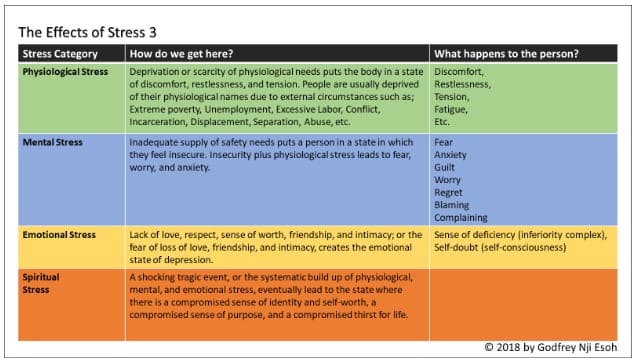
Human beings are social animals. The fact that we are created for community means that it is in relationship that we gain our sense of identity, our sense of worth, and our sense of fulfillment. The types of relationships we cultivate can be distinguished along the lines of the seven kinds of love that have been postulated by modern psychologists.
- • Erotic or sexual love (Eros)
- • Friendship and sharing (Philia)
- • Parental love (Storge)
- • Universal love (agape)
- • Playful or flirtatious love (Ludus)
- • Practical or dutiful love (Pragma)
- • Self-love (Philiautia)
Developmental psychology is the branch of psychology that studies human needs and behavior across the lifespan. Children rely on their parents and siblings for the fulfillment of their love and belonging needs. When they become adolescents their focus shifts to their peers. Later as they become young adults, and subsequently adults and seniors, they rely on their sexual partners and life-long friends for their love and belonging needs. Understanding this dynamic is a crucial step to identifying the vacuum in the life of a depressed person.
Depression results when a person experiences a consistent emotional vacuum. In the modern world, parents are too busy to give attention to their children. Even in homes with many children sibling river is an easy way in which the need for attention is demonstrated by children.
In the community or at school, children and adolescents turn to their peers for a sense of belonging. If for some reason a child is excluded by his/her peers, this becomes a source of depression. As people become older and ready for intimate friendships and romantic relationships, the lack of these or failures in relationships become a source of depression especially among middle-aged adults.
People who experienced loved and acceptance through all the stages of their development, that is from parents and siblings, from peers, from friends and partners, grow up to have a healthy sense of self-love which reflects on their relationship with others. Depression is common among those who were deprived at one stage or another, maybe because they grew up in broken homes or were maltreated by peers, of suffered abuse at the hands of those who were supposed to protect them.
We also have those who have developed an unhealthy sense of self-love due to the fact that they were pampered and spoiled as kids. These people indulge their ego to the degree that it feels like the only reason why other people exist is to make them feel good about themselves. When flattery is not forthcoming they sink into depression because they do not feel appreciated. Conventionally, depression is categorized clinically into recurrent depressive disorder, and bipolar disorder.
Recurrent depressive disorder:
This disorder involves repeated depressive episodes. During these episodes, the person experiences depressed mood, loss of interest and enjoyment, and reduced energy leading to diminished activity for at least two weeks. Many people with depression also suffer from anxiety symptoms, disturbed sleep and appetite and may have feelings of guilt or low self-worth, poor concentration and even medically unexplained symptoms.
Depending on the number and severity of symptoms, a depressive episode can be categorized as mild, moderate, or severe. An individual with a mild depressive episode will have some difficulty in continuing with ordinary work and social activities, but will probably not cease to function completely. During a severe depressive episode, it is very unlikely that the sufferer will be able to continue with social, work, or domestic activities, except to a very limited extent.
Bipolar affective disorder:
This type of depression typically consists of both manic and depressive episodes separated by periods of normal mood. Manic episodes involve elevated or irritable mood, over-activity, pressure of speech, inflated self-esteem and a decreased need for sleep.
Depending on the number and severity of symptoms, a depressive episode can be categorized as mild, moderate, or severe. An individual with a mild depressive episode will have some difficulty in continuing with ordinary work and social activities, but will probably not cease to function completely. During a severe depressive episode, it is very unlikely that the sufferer will be able to continue with social, work, or domestic activities, except to a very limited extent.
Response to Depression
Just as distress is physical stress and fear is mental stress, depression is emotional stress. This means that just as the response to physical stress is seen in a person’s bodily disposition, and the response to mental stress is seen in a person’s mental attitude, the response to emotional stress can be seen in the person’s emotions. The common signs of depression are:
- • Sustained sadness
- • Sustained apathy
- • Insomnia
- • Too much sleep
- • Persistent pains and aches
- • Persistent digestive problems
- • Change in appetite
- • Disruption in daily activity pattern
Adaptation to Depression
The adaptations to depression can be considered as the things that people do subconsciously to cover up the void that has been left by their lack of love, acceptance, and belonging. In order words, a depressed person’s adaptation mechanism is to do anything that will get him/her noticed. Some of these changes in lifestyle or behavior include:
Body Piercing and Tattooing
While we cannot say for sure that everyone who engages in body piercing and tattooing is a depressed person, the fact of the matter is that there are many people who pierce and tattoo their bodies because they want to become noticed or because they want to blend with a certain culture or peer group. The need to noticed and the need to succumb to peer pressure are classic adaptation to depression.
Anorexia
Anorexia is a form of self-torture in which people starve themselves into losing weight due to obsession over the need to slim down. It usually has dire health consequences but the victim is not attention to them because he/she is preoccupied with attaining the ideal shape and weight that will make him/her feel good and accepted.
Being possessive
Possessiveness is the emotional equivalent of greed and hoarding. It is inspired by the fear of losing the person we love.
Craving for attention
There are many ways in which people crave for attention. Some people become loud and aggressive when they are among people. Some people are a nuisance to their neighbors. Some people over dress while others move around half naked. Even the car you drive could be a way of drawing attention to yourself. In this digital age, the fastest growing outlet through which people crave attention is social medial platforms like Facebook, Instagram, and Twitter.
Stressing out
Stressing out is a way of focusing the energies on the body to make up for the deeper feeling of emptiness. This includes workaholics, people who are addicted to work, as well as those who are obsessed with working out in the gym.
Anger/temper tantrums
Depressed people are not only very irritable. They flare up at the slightest even that threatens their frail sense of self. Some express their temper tantrums through violence while others express theirs through withdrawal.
Obsession
Depressed people have the need to take attention away from themselves and stay busy with external things. Obsessive behaviors like gambling, talkativeness, gossiping, and fanatical tendencies (religious fanaticism, entertainment fanaticism, sports fanaticism, etc.) are some of the common outlets.
Bullying and superiority complex.
Bullies are people who gain their sense of being by lording it over other people. Their ego feeds on their ability to make other people look and feel small. They are compelled to make themselves feel important in this way, because otherwise, they feel inferior. Superiority complex is a silent form of bullying and really stems from a deep sense of insecurity.
Despondency: Response to Spiritual stress.
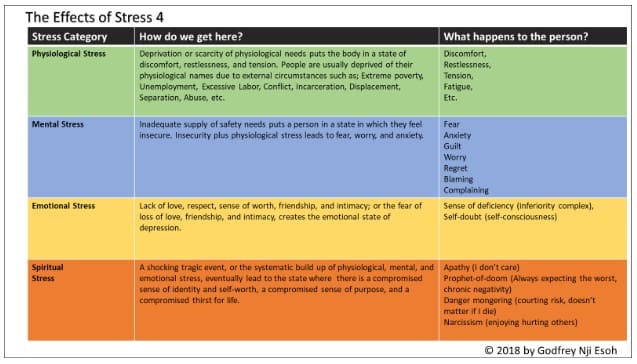
The ultimate form of stress is what we may call spiritual stress. Of course you won’t find the term spiritual stress in the psychology text books and journals, for the simple reason that conventional science limits itself to the superficial things that can be measured and manipulated.
The inability of conventional mental health and psychiatry to tackle the spiritual roots of mental health problems accounts for the overwhelming failure of this discipline in solving the problems that people go through. To be spiritually stressed simply means to lack a sense of identity and purpose. This is the state of despondency or hopelessness.
There are three paths that commonly lead to despondency:
The first and most common path is the lack of a spiritual foundation due to the materialistic culture in which people are raised. This is the epidemic of the western world.
The second path is when a person goes into shock due to some sudden tragic event and does not recover from it.
The third path is when a person progresses from distress, fear, depression, and ultimately enters the state of despondency, because his/her bitter experience of life has provided evidence that living is not worthwhile.
Response to despondency
Despondency is the end stage of depression and manifests in very obvious ways. The expressions of despondency are the classic red flags of suicidal tendencies. These include:
Researching ways to die or to kill
Talking about:
- • Killing themselves
- • Killing someone else
- • Hurting themselves
- • Hurting others
- • Feeling hopeless
- • Having no reason to live
- • Being a burden to others
- • Feeling trapped
- • Unbearable pain
Becoming obsessed with violence. Being extremely aggressive
Adaptations to despondency
When the spirit is broken, the final defense mechanism is to end it all. Suicide is ending one’s life physically. But there are many ways in which people tune out of life mentally, emotionally, and spiritually long before they ever end their physical life. These include:
- • Sadistic Behavior
- • Masochistic Behavior
- • Psychopathic Behavior
- • Sociopathic Behavior
- • Craving Risk or Danger
- • Dying by Suicide
